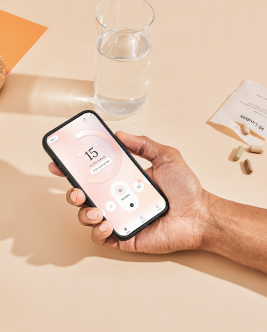nutrition
The Best Supplements for Vaginal Health and Balanced pH Levels
On This Page

It is important to do everything you can to support your vaginal microbiome. Here are a few supplements you can take for optimal vaginal health.
It is important to do everything you can to support your vaginal microbiome. Here are a few supplements you can take to promote optimal vaginal health.
When you think about your gut health, what comes to mind? Chances are, you think about things like eating a balanced diet, staying hydrated, and taking supplements. But, what about your vaginal health? The vagina is a self-cleaning organ that has its own ecosystem. Supporting your vaginal microbiome is just as important as supporting other areas of your health. While caring for your vaginal microbiome is similar to caring for your gut, there are some important factors to consider. These include understanding your body's natural processes and pH levels. However, this also includes understanding the different types of supplements you can take to help keep bacteria balanced.
From probiotics, vitamins, and minerals, to simply switching up your diet, here's everything you need to know about caring for your vaginal health.
Probiotics
Probiotics are live microorganisms that resemble the beneficial bacteria naturally present in your body. When taken as supplements, probiotics can help restore the balance of bacteria, including in the vagina, and promote vaginal health.
There are various strains of probiotics available, each with unique properties. While there is no definitive answer regarding the best probiotic strain for vaginal health, certain strains have shown effectiveness. For example, Lactobacillus rhamnosus and Lactobacillus acidophilus have been found to be effective in restoring vaginal flora. To fully harness the benefits of probiotics, look for a supplement with at least 8 to 20 million colony-forming units (CFU). This ensures an adequate quantity of bacteria to have a positive impact.
However, it's important to be aware of potential side effects associated with probiotics. The most common potential side effects include mild symptoms such as gas and bloating. Additionally, some formulations may contain ingredients that individuals may be sensitive to. Therefore, it's crucial to thoroughly examine the ingredient label before selecting a probiotic. If you experience any adverse effects, consider switching to a different strain or potency and always consult your doctor about your supplement plans.
When taking probiotics, it's essential to follow certain guidelines for optimal results. Start with a small dose and gradually increase it over time.
Side Effects of Probiotics
The most common side effects are mild and include gas, bloating, and nausea. Some people may also experience additional symptoms if close attention isn’t paid to the additional ingredients in some formulations. Some probiotics may have added ingredients that people can be sensitive to so it is very important to look at the ingredient label thoroughly.. If you experience any side effects when taking probiotics, consider switching to a different strain or potency. Always talk to your doctor about your supplement plans.
How to Take Probiotics
It’s important to take probiotics carefully in order to get the best results. Start with a small dose and gradually increase it over time. It’s also helpful to take them with food. Be sure you take them consistently for at least a few weeks to see results. Always follow the instructions on the bottle. Some require refrigeration to keep the bacteria alive while others only require you to keep them out of direct sunlight.
Consider Probiotic-Rich Food
You don’t have to get your good bacteria from supplements like probiotics. While that’s an easy way to consume the daily recommended value, you can also get them from probiotic-rich foods. Yogurt, kefir, kimchi, and sauerkraut are perhaps three of the most popular.
Zinc
In addition to probiotics, another supplement that holds potential benefits for vaginal health is zinc. In fact, this study has found that zinc supplementation may support testosterone levels in postmenopausal women. This finding is significant because testosterone plays a key role in maintaining vaginal health, including promoting lubrication and supporting the integrity of vaginal tissue.
Vitamin E
Vitamin E is another supplement that has been touted for supporting vaginal health, particularly in postmenopausal women. Vitamin E is mostly known for its antioxidant properties, exerting positive effects on the immune system and helping to combat oxidative stress. But it also plays a role in supporting the vagina. For instance, this study found that a vaginal suppository that includes vitamin E may support vaginal health. However, you should not try to insert a suppository or use any supplement without talking to your doctor first.
Vitamin D
When we think of vitamin D, bone health and immune function are typically the first things that come to mind. But the benefits of vitamin D go far beyond that. Research shows that vitamin D may improve vaginal health during menopause. Additionally, emerging research has revealed a connection between vitamin D levels and certain vaginal bacteria during pregnancy.
Vitamin C
Vitamin C levels are mostly associated with healthy immune function. This is because vitamin C works as an antioxidant in the body, fighting free radicals and enhancing immune responses. But, apart from its role as an immune booster, vaginal gels that include vitamin C (ascorbic acid) have been shown to lower vaginal pH. Lowering vaginal pH can help create an environment that is more conducive to maintaining a healthy vaginal microbiome. However, the use of any vaginal gels or supplements should only be taken under the guidance and recommendation of a medical provider.
Fish Oil
While the direct effects of fish oil on vaginal health are still being researched, there are some potential benefits worth considering. During menopause, hormonal changes can lead to decreased lubrication in the vaginal area. Omega-3 fatty acids present in fish oil may support healthy lubrication by promoting the production of moisture and improving vaginal tissue health.
Additionally, a study has indicated that combining fish oil with vitamin D, especially in individuals with vitamin D deficiency, may increase estrogen levels.
Sea Buckthorn Oil
Sea buckthorn oil is derived from the berries of the sea buckthorn plant. This oil has been making strides in the wellness space due to its array of health-promoting properties. Although research on its specific effects on vaginal health is limited, a study suggests that sea buckthorn oil may have a positive impact on mucosal health in the vaginal area. These results are promising for those undergoing menopause, as it can be a natural and therapeutic way to reduce vaginal dryness and promote a healthy pH.
Microbiomes and Vaginal Health
We’ve mentioned the vaginal microbiome briefly, but let’s explore more on this topic and how maintaining this microbiome is critical for all aspects of vaginal health.
The vaginal microbiome is the collection of all the microbes (bacteria, fungi, etc.) that live in the vagina. A healthy vaginal microbiome is key to maintaining vaginal health and preventing infections.
Similar to gut health, the goal is to ensure your levels of good bacteria concentration are balanced. After all, balance is important for reproductive and sexual health. So, what kinds of bacteria are we talking about here?
The most common type of bacteria is Lactobacillus, which helps to keep the vagina acidic and prevents other harmful bacteria from growing. If you’ve ever taken a probiotic then you’ve likely seen the name Lactobacillus before (or even the other popular bacteria, Bifidobacterium).
Now, let’s dive in to explore more about the function of Lactobacillus in your body.
How Lactobacillus Works to Regulate Vaginal Microbiome
Lactobacillus is a family of bacteria. You can find quite a few different types of this bacteria in a healthy human vagina.
Variations include:
- Lactobacillus crispatus
- Lactobacillus jensenii
- Lactobacillus gasseri
- Lactobacillus iners
Overall, these types of lactobacilli help prevent the invasion of harmful bacteria. They do this by producing lactic acid via a fermentation process. This helps keep the pH level of the vagina acidic.
Healthy Vaginal pH Levels
Ideally, your pH levels should be between 3.8 and 4.5 to maintain optimal vaginal health.
Why so acidic? This acidic environment is key to maintaining a healthy microbiome. When your pH levels are higher, your vaginal microbiome is more conducive to potential bacterial imbalances.
Other helpful functions of Lactobacillus that benefit your vaginal microbiome include the bacteria’s ability to:
- Stick to the vaginal wall and compete with other not-so-beneficial bacteria and yeast.
- Produce hydrogen peroxide and lactic acid, which can be toxic to other non-beneficial bacteria.
All in all, learning about bacteria such as Lactobacillus is an important part of immune health and immune function.
If you’re not sure how to monitor your pH levels, then we suggest measuring them with at-home kits. You can usually purchase these from your local pharmacy or health store.
pH Imbalance Symptoms
It's important to understand the role of bacteria and yeast as part of your overall vaginal and sexual health. However, you don't need to always be on guard. Your vagina is actually working around the clock to keep itself clean and protected.
The vaginal canal is lined with mucus-producing cells that release discharge to cleanse the vaginal area and keep the microbiome balanced. This is why you likely see vaginal discharge during different parts of your cycle.
Likewise, some studies suggest that hormones such as estrogen may also play a role in maintaining the pH levels of the vagina.
Therefore, the composition of vaginal microbiota can change depending on where you’re at in your gynecological lifecycle (for example, if you’ve been through menopause or not).
While it might be unsightly and somewhat uncomfortable, vaginal discharge can be normal if it’s odorless and has a clear or white color. However, certain types of discharge can be a sign of pH imbalance (be sure to talk to your doctor if you suspect any imbalances or experience any symptoms).
What can you expect normally throughout your cycle?
The amount of vaginal discharge may increase as you ovulate. At this time in your cycle, the vaginal discharge is usually clear, stretchy, and similar in consistency to egg whites.
After you ovulate, the vaginal discharge typically becomes thicker and white or cream-colored. This vaginal discharge is caused by the hormone progesterone during the luteal phase.
If you experience vaginal discharge that is foul-smelling, itchy, or accompanied by other symptoms like pain, redness, or burning, then it may be a sign of infection and you should see a doctor.
Common Factors that Negatively Affect Vaginal Microbiome
The vaginal microbiome is a delicate ecosystem of good bacteria that helps to keep the vagina healthy. Unfortunately, this balance can be easily disrupted.
Common factors that can negatively affect the vaginal microbiome include douching, using perfumed soaps or powders, wearing tight-fitting clothing, and using antibiotics frequently. However, your lifestyle does play into your vaginal health as well.
High-Sugar Diets
Diets high in sugar can contribute to a shift in your vaginal microbiome and promote more yeast growth. This can alter your pH and lead to an array of uncomfortable symptoms, such as itching and irritation.
Vaginal Sprays, Soaps & Detergents
Synthetically fragranced products such as vaginal sprays, soaps and detergents, and douches may disrupt the microbiome and flora by removing beneficial bacteria. When this happens it can lead to an overgrowth of pathogenic bacteria.
Spermicidal Gels or Lubricants
Spermicidal gels or lubricants can also disrupt your natural vaginal microbiome depending on the ingredients in the products. This also goes for foreign products that are introduced into your vagina. If you’re not careful, they can damage the tissue and lead to discomfort.
While this doesn’t mean you should stop using lubricants or other gels, it simply means that you should be mindful of the ingredients in the products you’re using.
Sexual Activity
Sexual activity can also briefly affect your vaginal microbiome health, particularly if you’re having sex with someone with male anatomy.
This is because semen has a neutral to alkaline pH and results in significant buffering of vaginal secretions. Seminal fluid also contains enzymes that inactivate hydrogen peroxide. Likewise, bacteria from someone’s mouth can be introduced to the vaginal area as well.
Again, while this doesn’t mean you need to swear off sex entirely, it’s just something to consider as you care for your vaginal and reproductive health.
Excess Moisture
Excess moisture in the area can also create an environment conducive to more bacteria growth.
This often occurs when you swim and keep a wet bathing suit on. It can also occur when you sweat excessively and stay in your workout clothes. You might also notice issues if you wear clothing or underwear that isn’t breathable. Instead, opt for cotton!
Antibiotics
Antibiotics are one of the leading causes of microbiome disruptions. This is because antibiotics are designed to kill bacteria, but they don't have the ability to discriminate between good and bad bacteria. This means that they can kill off the healthy bacteria in your vagina, along with the bad bacteria. In order to maintain a healthy vaginal microbiome, it's important to only use antibiotics when absolutely necessary. When you do need to take them, be sure to take probiotics as well to help replenish the good bacteria in your vagina.
The Bottom Line
To promote optimal vaginal health and maintain balanced pH levels, several supplements can be beneficial. Probiotics, particularly those containing Lactobacillus strains, help restore the delicate balance of vaginal flora. Additionally, certain vitamins and minerals, including zinc, vitamins E, D, and C have demonstrated their effectiveness in promoting vaginal health during and after menopause. Furthermore, the use of fish oil and sea buckthorn oil shows promising effects when it comes to supporting mucosal health in the vaginal area. While these supplements can be helpful, it's important to consult with a medical provider before using any vaginal gels or supplements. Ultimately, embracing a healthy lifestyle, including consuming a balanced diet and probiotic-rich foods, can naturally contribute to optimal vaginal health and balanced pH levels.
If you’re interested in incorporating vitamins and supplements into your everyday health routine, it’s important to ensure you’re choosing the right ones for your needs. Take our quiz to find out which supplements are best for you.



